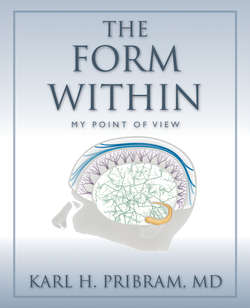Читать книгу The Form Within - Karl H Pribram - Страница 34
На сайте Литреса книга снята с продажи.
Brain Patterns
ОглавлениеMy 1971 book Languages of the Brain begins:
‘I love you.’ It was spring in Paris and the words held the delightful flavor of a Scandinavian accent. The occasion was a UNESCO meeting on the problems of research on Brain and Human Behavior. The fateful words were not spoken by a curvaceous blonde beauty, however, but generated by a small shiny metal device in the hands of a Swedish psycholinguist.
The device impressed all of us with the simplicity of its design. The loudspeaker was controlled by only two knobs. One knob altered the state of an electronic circuit that represented the tensions of the vocal apparatus; the other regulated the pulses generated by a circuit that simulated the plosions of air puffs striking the pharynx.
Could this simple device be relevant to man’s study of himself? Might not all behavior be generated and controlled by a neural mechanism equally simple? Is the nervous system a “two knob” dual process mechanism in which one process is expressed in terms of neuroelectric states and the other in terms of distinct pulsatile operators on those states? That the nervous system does, in fact, operate by impulses has been well documented. The existence of neuroelectric states in the brain has also been established, but this evidence and its significance to the study of psychology has been slow to gain acceptance even in neuro-physiology. We therefore need to examine the evidence that makes a two-process model of brain function possible.
What needed to be established is that brain patterns are formed by interactions between: 1) a formative “web” of dynamic states that involves the fine branches of brain cells (called “dendrites,” Latin for “small branches”) and their connections (membranes, glial cells, chemical synapses and electrical junctions) and 2) “circuits” composed of large fibers (axons) that operate in such a way as a) to sample the web, and b) to convey the resulting samples from one brain region to another and also convey samples from sensory receptors to the brain and from the brain to glands and muscles.
In a sense, the web composes the form of a process, while the circuits address that form, enabling contemplation or action.
